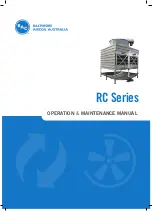
26
2. Sheave Alignment:
Fixed sheaves — To check the location of the fixed sheaves
on the shafts, a straightedge or a piece of string can be used. If
the sheaves are properly aligned, the string will touch them at
the points indicated by the arrows in Fig. 26.
Adjustable sheaves — To check the location of adjustable
sheave on shaft, make sure that the centerlines of both
sheaves are in line and parallel with the bearing support chan-
nel. See Fig. 26. Adjustable pitch drives are installed on the
motor shaft. Carrier recommends that adjustable sheaves
should only be used for initial balancing and be replaced with
fixed pitch sheaves by the air balancer prior to the final sys-
tem air balance.
Fig. 26 — Determining Sheave-Shaft Alignment
3. Rotate each sheave one-half revolution to determine whether
the sheave is wobbly or the drive shaft is bent. Correct any
misalignment.
4. With sheaves aligned, tighten cap screws evenly and progres-
sively.
NOTE: There should be a
1
/
8
in. to
1
/
4
in. gap between the mating
part hub and the bushing flange. If gap is closed, the bushing is
probably the wrong size.
5. With taper-lock bushed hubs, be sure the bushing bolts are
tightened evenly to prevent side-to-side pulley wobble.
Check by rotating sheaves and rechecking sheave alignment.
When substituting field-supplied sheaves for factory-supplied
sheaves, consider that fan shaft sheave has been factory bal-
anced with fan and shaft as an assembly. For this reason, sub-
stitution of motor sheave is preferable for final speed
adjustment.
V-BELTS
When installing or replacing belts, always use a complete set of
new belts. Mixing old and new belts will result in the premature
wear or breakage of the newer belts.
Refer to label on inside of fan access door for information on fac-
tory-supplied drive.
1. Always adjust the motor position so that V-belts can be
installed without stretching over grooves. Forcing belts can
result in uneven stretching and a mismatched set of belts.
2. Do not allow belt to bottom out in sheave.
3. Tighten belts by turning motor-adjusting jackscrews. Turn
each jackscrew an equal number of turns.
4. Equalize belt slack so that it is on the same side of belt for all
belts. Failure to do so may result in uneven belt stretching.
5. Tension new drives at the maximum deflection force recom-
On current production, the correct tension information is listed on
the fan drive label. For older equipment or for units with field-
modified drives, use the deflection formula given in the following
example and the tension data from Fig. 27.
Fig. 27 — Fan Belt Tension Data
EXAMPLE:
Given:
Belt Span 16 in.
Belt Cross-Section A, Super Belt
Small Sheave PD 5 in.
Deflection = Belt Span/64
CAUTION
Do not exceed maximum fan speed rpm with adjustable
sheave or equipment damage could occur.
LEGEND
PD —
Pitch Diameter, inches
BELT
CROSS
SECTION
SMALL
SHEAVE
PD RANGE
(in.)
DEFLECTION FORCE (lb)
Super Belts Notch Belts Steel Cable
Belts
Min
Max
Min
Max
Min
Max
A
3.0- 3.6
3
4
1
/
4
3
7
/
8
5
1
/
2
3
1
/
4
4
3.8- 4.8
3
1
/
2
5
4
1
/
2
6
1
/
4
3
3
/
4
4
3
/
4
5.0- 7.0
4
5
1
/
2
5
6
7
/
8
4
1
/
4
5
1
/
4
B
3.4- 4.2
4
5
1
/
2
5
3
/
4
8
4
1
/
2
5
1
/
2
4.4- 5.6
5
1
/
8
7
1
/
8
6
1
/
2
9
1
/
8
5
3
/
4
7
1
/
4
5.8- 8.6
6
3
/
8
8
3
/
4
7
3
/
8
10
1
/
8
7
8
3
/
4
C
7.0- 9.4
11
1
/
4
14
3
/
8
13
3
/
4
17
7
/
8
11
1
/
4
14
9.6-16.0
14
1
/
8
18
1
/
2
15
1
/
4
20
1
/
4
14
1
/
4
17
3
/
4
5V
4.4- 6.7
—
—
10
15
—
—
7.1-10.9
10
1
/
2
15
3
/
4
12
7
/
8
18
3
/
4
—
—
11.8-16.0
13
19
1
/
2
15
22
—
—
8V
12.5-17.0
27
40
1
/
2
—
—
—
—
18.0-22.4
30
45
—
—
—
—
















































